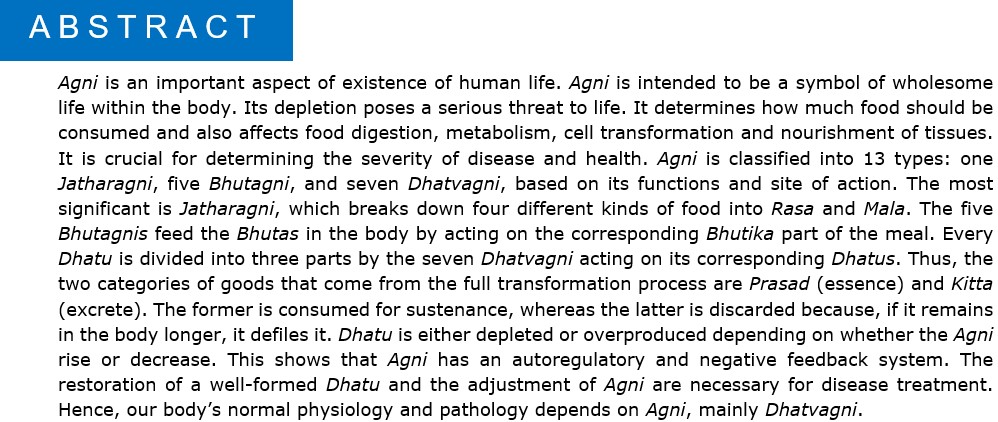Role of Dhatvagni in disease pathogenesis
DOI:
https://doi.org/10.21760/jaims.9.1.13Keywords:
Agni, Jatharagni, Bhutagni, Dhatvagni, Bhutika, Prasad, Kitta, AyurvedaAbstract
Agni is an important aspect of existence of human life. Agni is intended to be a symbol of wholesome life within the body. Its depletion poses a serious threat to life. It determines how much food should be consumed and also affects food digestion, metabolism, cell transformation and nourishment of tissues. It is crucial for determining the severity of disease and health. Agni is classified into 13 types: one Jatharagni, five Bhutagni, and seven Dhatvagni, based on its functions and site of action. The most significant is Jatharagni, which breaks down four different kinds of food into Rasa and Mala. The five Bhutagnis feed the Bhutas in the body by acting on the corresponding Bhutika part of the meal. Every Dhatu is divided into three parts by the seven Dhatvagni acting on its corresponding Dhatus. Thus, the two categories of goods that come from the full transformation process are Prasad (essence) and Kitta (excrete). The former is consumed for sustenance, whereas the latter is discarded because, if it remains in the body longer, it defiles it. Dhatu is either depleted or overproduced depending on whether the Agni rise or decrease. This shows that Agni has an autoregulatory and negative feedback system. The restoration of a well-formed Dhatu and the adjustment of Agni are necessary for disease treatment. Hence, our body’s normal physiology and pathology depends on Agni, mainly Dhatvagni.
Downloads
References
Acharya YT. Sushruta Samhita. Chaukhambha Surbharti Prakashan; 2014. Dalhancharya’s nibandhasamgraha Sanskrita Commentary On, Sutrasthan 13/41.
Acharya YT, editor. Charak Samhita. Varanasi: Chaukhamba Surbharti Prakashan; [date unknown]. Chakrapanidatta’s Ayurvedadipika Sanskrita Commentary On, Chikitsasthan, Chapter 15.
Acharya YT, editor. Charak Samhita. Varanasi: Chaukhamba Surbharti Prakashan; [date unknown]. Chakrapanidatta’s Ayurvedadipika Sanskrita Commentary On, Sutrasthan, Chapter 4/3.
Acharya YT, editor. Charak Samhita. Varanasi: Chaukhamba Surbharti Prakashan. Chakrapanidatta’s Ayurvedadipika Sanskrita Commentary On, Vimanasthan, Chapter 8.
Acharya YT, editor. Charak Samhita. Varanasi: Chaukhamba Surbharti Prakashan; Chakrapanidatta’s Ayurvedadipika Sanskrita Commentary On, Chikitsasthan, Chapter 15/38.
Acharya YT, editor. Charak Samhita. Varanasi: Chaukhamba Surbharti Prakashan; Chakrapanidatta’s Ayurvedadipika Sanskrita Commentary On, Chikitsasthan, Chapter 15/39-40.
Acharya YT, editor. Charak Samhita. Varanasi: Chaukhamba Surbharti Prakashan; Chakrapanidatta’s Ayurvedadipika Sanskrita Commentary On, Chikitsasthan, Chapter 15/15.
Acharya YT, editor. Charak Samhita. Varanasi: Chaukhamba Surbharti Prakashan; Chakrapanidatta’s Ayurvedadipika Sanskrita Commentary On, Sutrasthan, Chapter 30/28.
Vagbhata. Ashtanga Hridayam. 1st ed. Varanasi: Krishnadas Academy; 2000. Sharira Sthana 3/62.
Vagbhata. Ashtanga Sangraha. 3rd ed. Varanasi: Chaukhamba Sanskrit Series Office; 2012. Sharira Sthana 6.
Vagbhata. Ashtanga Hridayam. 1st ed. Varanasi: Krishnadas Academy; 2000. Sutra Sthana 11/34.
Acharya YT, editor. Charak Samhita. Varanasi: Chaukhamba Surbharti Prakashan; Chakrapanidatta’s Ayurvedadipika Sanskrita Commentary On, Sutrasthan, Chapter 28/3.
Acharya YT, editor. Charak Samhita. Varanasi: Chaukhamba Surbharti Prakashan; Chakrapanidatta’s Ayurvedadipika Sanskrita Commentary On, Sutrasthan, Chapter 28/3.
Acharya YT, editor. Charak Samhita. Varanasi: Chaukhamba Surbharti Prakashan; Chakrapanidatta’s Ayurvedadipika Sanskrita Commentary On, Chikitsasthan, Chapter 5/136.
Acharya YT, editor. Charak Samhita. Varanasi: Chaukhamba Surbharti Prakashan; Chakrapanidatta’s Ayurvedadipika Sanskrita Commentary On, Chikitsasthan, Chapter 4/8.















